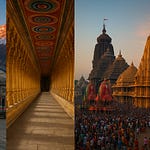Nestled in the heart of the holy land of Vrindavan, Kusum Sarovar is a sacred and historically significant reservoir deeply associated with the divine love of Shri Radha and Shri Krishna.
The name itself reflects its essence — Kusum meaning flowers and Sarovar meaning lake — a serene place once adorned with fragrant blooms and lush Kadamba trees.
This sacred site stands as a living testimony to the Dwapara Yuga's celestial leelas (divine pastimes) of Radha and Krishna. Even today, Kusum Sarovar continues to emanate a spiritual aura that captivates the hearts of devotees and pilgrims worldwide.
❓ Why is Kusum Sarovar Special?
Witness to Radha-Krishna's Loving Pastimes: Kusum Sarovar was where Shri Radha, along with her sakhis (friends), would come under the pretense of collecting flowers but with the deeper intention of meeting Krishna.
A Symbol of Selfless Love and Seva (Service): In one divine pastime, Krishna, disguised as a gardener, helped Radharani when her garment got entangled in thorns, portraying the spirit of selfless love and service.
Spiritual Energy Center: The very soil of Kusum Sarovar is believed to be sanctified by the footsteps of Radha and Krishna, making it a spiritually charged destination for seekers of divine love.
📖 What is Kusum Sarovar?
A Serene Ancient Water Body: Originally a beautiful natural lake surrounded by a profusion of flowers and shady trees like Kadamba.
Architectural Splendor: Later, magnificent structures including chhatris (cenotaphs), beautiful ghats, and pavilions were added, enhancing its beauty and significance.
A Sacred Pilgrimage Site: Today, it stands not only as a historical monument but also as a vibrant center of bhakti (devotion) and spiritual meditation.
🔎 How is Kusum Sarovar Connected to the Divine Leelas?
Shri Radha used to visit this grove daily with her sakhis to gather flowers for her worship and secretly meet Krishna.
During one such visit, Radharani’s garment got stuck in the thorns, and Krishna, disguised as a gardener, appeared to help her.
This act symbolized divine humility, service, and deep unconditional love — principles central to the path of bhakti.
The playful exchanges, loving glances, and tender moments shared here between Radha and Krishna are forever etched into the spiritual memory of Vrindavan.
📅 When Did These Pastimes Happen?
These sacred events took place during the Dwapara Yuga, when the Supreme Personality of Godhead, Shri Krishna, performed His enchanting childhood and youthful pastimes in Vrindavan.
Especially during Spring and Sharad (autumn) seasons, when the groves were lush with fragrant blooms, Kusum Sarovar was vibrant with activity.
🛕 For Whom is Kusum Sarovar?
Devotees and Pilgrims: Those seeking the nectar of Radha-Krishna's love.
Spiritual Seekers: Aspirants desiring to experience bhakti and inner peace.
Historians and Lovers of Indian Culture: Those interested in the ancient heritage, art, and architecture linked with divine stories.
Travelers and Explorers: Those yearning to experience the timeless charm and mysticism of Vrindavan.
🧡 Religious Significance
Meeting Place of Divine Lovers: Kusum Sarovar is one of the sacred locations where Radha and Krishna’s love blossomed.
A Center for Bhakti Yoga: Chanting, kirtan, and meditation near the waters of Kusum Sarovar are said to awaken deep spiritual realizations.
Purification and Blessings: Bathing in or even touching the sacred waters is believed to purify the soul and awaken the dormant love for Krishna within the heart.
Association with Saints: Great saints like Swami Haridas and others glorified Kusum Sarovar in their hymns and bhajans.
🛕 Religious Importance
Shastric and Bhajan Traditions revere Kusum Sarovar as a sacred site where love, surrender, and service converge.
Devotees believe that heartfelt prayer and meditation here help one attain divine love (prem-bhakti) and a deeper connection with Radha-Krishna.
It is considered a must-visit for pilgrims undertaking the Braj Yatra (pilgrimage across Krishna's Vrindavan pastimes).
📜 Historical Details
While its original sanctity dates back to Dwapara Yuga, the present architectural structures were developed much later.
In the 18th century, Raja Suraj Mal of Bharatpur commissioned the construction of grand chhatris and ghats to preserve the glory of the place.
The architecture blends Rajasthani and Mughal styles, with exquisite carvings, paintings depicting Radha-Krishna’s pastimes, and splendid craftsmanship.
🌿 Present-Day Kusum Sarovar
The serene pond, artistic cenotaphs, and peaceful ambiance continue to attract devotees, meditators, and tourists.
Early mornings and evenings are especially enchanting, as the sunrise and sunset reflections on the lake create a surreal, almost otherworldly atmosphere.
On auspicious days like Sharad Purnima, Radhashtami, and during Kartika month, Kusum Sarovar becomes a hub of devotional festivities and pilgrimages.
✨ How to Experience Kusum Sarovar
🛕 Timings
General Visit:
Kusum Sarovar is open for visitors from 6:00 AM to 8:00 PM daily.Best Time for Darshan:
The most spiritually uplifting time to visit is during the early morning hours between 6:00 AM and 9:00 AM, and in the evening from 5:00 PM till sunset, when the atmosphere is serene and devotional vibrations are at their peak.Special Aarti:
On festivals and special Braj Yatra occasions, special aartis (ritual worship ceremonies) are performed at Kusum Sarovar, filling the surroundings with devotional songs, lamps, and divine energy.
🚗 How to Reach
By Air:
Nearest Airport: Indira Gandhi International Airport, Delhi (~160 km)
From there, taxi or cab to Vrindavan (Approx. 3-4 hours).By Train:
Nearest Railway Station: Mathura Junction (~15 km)
Auto rickshaws, cabs available to Vrindavan.By Road:
Vrindavan is well connected via highways. Private taxis, buses, and self-drives are convenient options.Local Transport:
E-rickshaws, Auto-rickshaws, and walking are the best ways to explore Vrindavan.
📍 Location
Kusum Sarovar lies close to Govardhan Hill, around 22 km from Vrindavan town.
It can be combined with Govardhan Parikrama (circumambulation).
🛏️ Nearby Accommodation
Budget Options: Guesthouses, Ashrams, Budget Hotels.
Mid-range Options: Krishna International, Radha Ashok Hotel.
Premium Stay: MVT Guesthouse, Nidhivan Sarovar Portico.
Advance booking is recommended during festival seasons.
🏵️ Nearby Attractions
Govardhan Hill (Giriraj Parvat):
A sacred site of Krishna’s Govardhan Leela, located very close to Kusum Sarovar. Pilgrims perform parikrama here.Radha Kund and Shyam Kund:
Considered the most sacred water bodies by Gaudiya Vaishnavas; located near Kusum Sarovar.Mansi Ganga:
A holy lake where Krishna performed his water pastimes.Barsana and Nandgaon:
The divine villages of Radha and Krishna, rich in beautiful temples and legends.Vrindavan Temples:
Banke Bihari Temple, ISKCON Temple, Radha Raman Temple, Prem Mandir — all are within easy reach.
🙏 Special Message for Devotees
Kusum Sarovar is not just a picturesque location; it is a living breathing temple of love, surrender, and divine intimacy.
For a true pilgrim, a visit here is an opportunity to reconnect with the timeless spirit of Radha and Krishna, to bathe in the nectar of their leelas, and to awaken dormant devotion in one's heart.
Sitting quietly by its serene waters, chanting the holy names, one can almost hear the gentle laughter of the Divine Couple resonating in the gentle breeze.
Kusum Sarovar stands as a symbol of the eternal, pure, and selfless love between Radha and Krishna.
It is a gateway for devotees to enter into deeper realms of bhakti, a place where every breath feels saturated with divine love.
A visit to Kusum Sarovar is not just a travel experience — it is a soul’s pilgrimage to the heart of Vrindavan’s eternal pastimes.
Those who come here with devotion leave with a heart brimming with peace, love, and divine remembrance.
🌸 Radhe Radhe! 🌸










